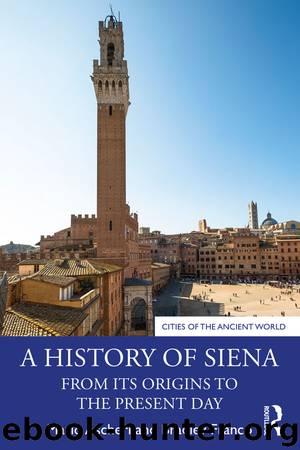A History of Siena by Mario Ascheri;Bradley Franco;

Author:Mario Ascheri;Bradley Franco;
Language: eng
Format: epub
Publisher: Taylor & Francis (CAM)
Published: 2019-03-21T16:00:00+00:00
From Pandolfo Petrucci to the war for Siena (1487–1555)
Upon the collapse of the governing coalition in 1480, Siena’s power blocs wrestled for control. In the chaotic years that followed, Siena’s monti made several attempts to establish new regimes, even resorting to exiling the Nine in 1483 out of fear of their growing strength. Those fears proved to be well grounded, as the Nine, under the control of Pandolfo Petrucci, clandestinely reentered the city in 1487 and seized control of the mechanisms of civic governance. A member of the powerful Petrucci clan, Pandolfo had served as a political tribune for Sienese security and as head of the Camera del Commune, a position that put Pandolfo in charge of the city’s assets, including its fortresses and armaments.
Though Pandolfo would maintain the semblance of republican governance in Siena, he aggressively sought to secure his position and make himself prince of Siena. The invasion of Charles VIII of France in 1494 accelerated Pandolfo’s plans, allowing him to crack down on civil liberties in the name of security, leading to the marginalization of republican councils and the placement of ever greater power in his hands. He quickly consolidated his power, seizing his brother’s fortune upon his death in 1497, and then marrying into the powerful Borghese family in order to form an alliance with his father-in-law, Niccolò Borghese, and gain near total control of the Sienese state. Niccolò soon came to regret his decision to help Pandolfo and conspired with other Sienese elites to kill him. Pandolfo caught wind of the assassination plan and had Niccolò and his fellow conspirators killed. Using the recent threats to his life as his excuse, in the name of national security, Pandolfo finally managed to seize complete control of political power in 1500.
At the same time, like many tyrants, Pandolfo recognized the political benefit of formally maintaining and showing respect for Siena’s republican institutions. Thus, despite the fact that he had transformed the government into a tyrannical regime and family dynasty that would survive his death in 1512, he always publically presented himself as the defender of the Sienese Republic. Historians have always found his legacy to be complicated. Ruthless and often violent, Pandolfo set in motion the collapse of the city’s representative institutions, making it easier for later princes to find acceptance in Siena, beginning with Cosimo de Medici a half century later. On the other hand, the collapse of republican regimes was the rule, not the exception, in sixteenth-century Europe, the age of Niccolò Machiavelli and of increasingly powerful and centralized states under the control of princes and kings. In other words, the collapse of the Sienese Republic was, in many ways, inevitable. And judged on the merits of his tenure as prince of Siena, Pandolfo oversaw an economic recovery in the city, patronized the city’s cultural institutions, including the university and its college, and constructed beautiful palaces throughout the city, including the luxurious palace that still dominates the square of the Baptistery today. Siena’s leading citizens seem to have accepted Pandolfo’s tyranny out of self-interest.
Download
This site does not store any files on its server. We only index and link to content provided by other sites. Please contact the content providers to delete copyright contents if any and email us, we'll remove relevant links or contents immediately.
Cecilia; Or, Memoirs of an Heiress — Volume 1 by Fanny Burney(32063)
Cecilia; Or, Memoirs of an Heiress — Volume 3 by Fanny Burney(31458)
Cecilia; Or, Memoirs of an Heiress — Volume 2 by Fanny Burney(31409)
The Great Music City by Andrea Baker(30781)
We're Going to Need More Wine by Gabrielle Union(18633)
All the Missing Girls by Megan Miranda(14743)
Pimp by Iceberg Slim(13780)
Bombshells: Glamour Girls of a Lifetime by Sullivan Steve(13686)
Fifty Shades Freed by E L James(12917)
Talking to Strangers by Malcolm Gladwell(12876)
Norse Mythology by Gaiman Neil(12830)
For the Love of Europe by Rick Steves(11493)
Crazy Rich Asians by Kevin Kwan(8890)
Mindhunter: Inside the FBI's Elite Serial Crime Unit by John E. Douglas & Mark Olshaker(8702)
The Lost Art of Listening by Michael P. Nichols(7163)
Enlightenment Now: The Case for Reason, Science, Humanism, and Progress by Steven Pinker(6876)
The Four Agreements by Don Miguel Ruiz(6319)
Bad Blood by John Carreyrou(6278)
Weapons of Math Destruction by Cathy O'Neil(5833)
